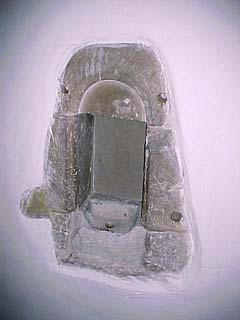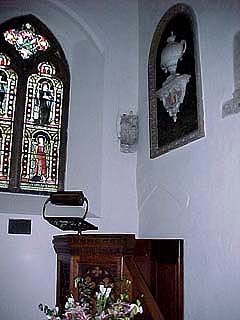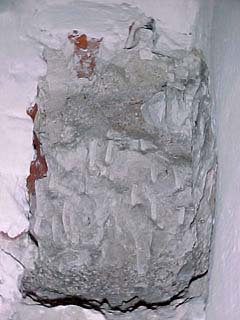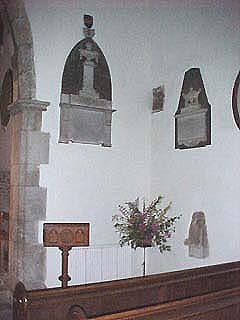|
Saint Martin's Church - description
page 5 |
|
This is the fifth page of the booklet about Saint Martin's Church. To go back to the last page click here. To go back to the Saint Martin's main page click here. |
|
Moving along the Aisle, on our left, half-way along the wall, are the remains of a Norman doorway, blocked up in 1840. At the side of this door and level with the top of the pew is an ancient Stoup for holy water. It is in an unusual position, as stoups are usually in the porch outside the West or South-west door. A little further Eastwards, hanging on the wall, is a very fine piece of Flemish carving, depicting St. Martin of Tours dividing his cloak with the beggar. The story of St. Martin is briefly given at the end of this book. This carving was bought by the Lady Alwyne Compton in an antique shop in Worcester in 1884. The date on the carving is 1583. The coats of arms at the top are those of Phillip II. [This carving was stolen some twenty years ago, I understand.] ^ The roof of the Nave is worth looking up at. It dates from the 14th century. Certain beams have had to be renewed and can quite easily be picked out.
The chancel roof is quite modern. The entire roof was treated against Death Watch Beetle under the direction of Professor Lefroy in 1924. In pre-Reformation days St. Martin's had three altars - the High Altar dedicated to St. Martin, the Altar of the Blessed Virgin, standing where the pulpit is now, and the Altar of St. Nicholas, in the South-cast corner opposite. In the South wall at the side of where this Altar stood is a beautiful Norman Piscina. This was used by the Priest for the emptying of the water after the ceremonial washing of the sacred vessels at the Mass. It is very small but one of the best preserved Norman ones remaining in England to-day. It still has the hole, for the water, and also the original tool marks on the face and sides. The back has been restored.
^ No record or traces have been found of a Rood-screen or loft, and it is assumed that the Rood took the form of a plain oak beam spanning the Chancel Arch. On the beam were the Crucifix, together with images of St. Mary and St. Nicholas. Hanging in front would be the Holy Cross Light, perpetually burning. One of the holes for the end of the beam can be seen in the corner near the Piscina and about ten feet from the ground. The corresponding one near the Pulpit was filled in when the window opening was cut. [This is not true - or else it has been oncovered again! See the photos below.] The Rood and Altars were destroyed at the Reformation.
Left (north) wall showing rood beam hole above the pulpit.
^ |




